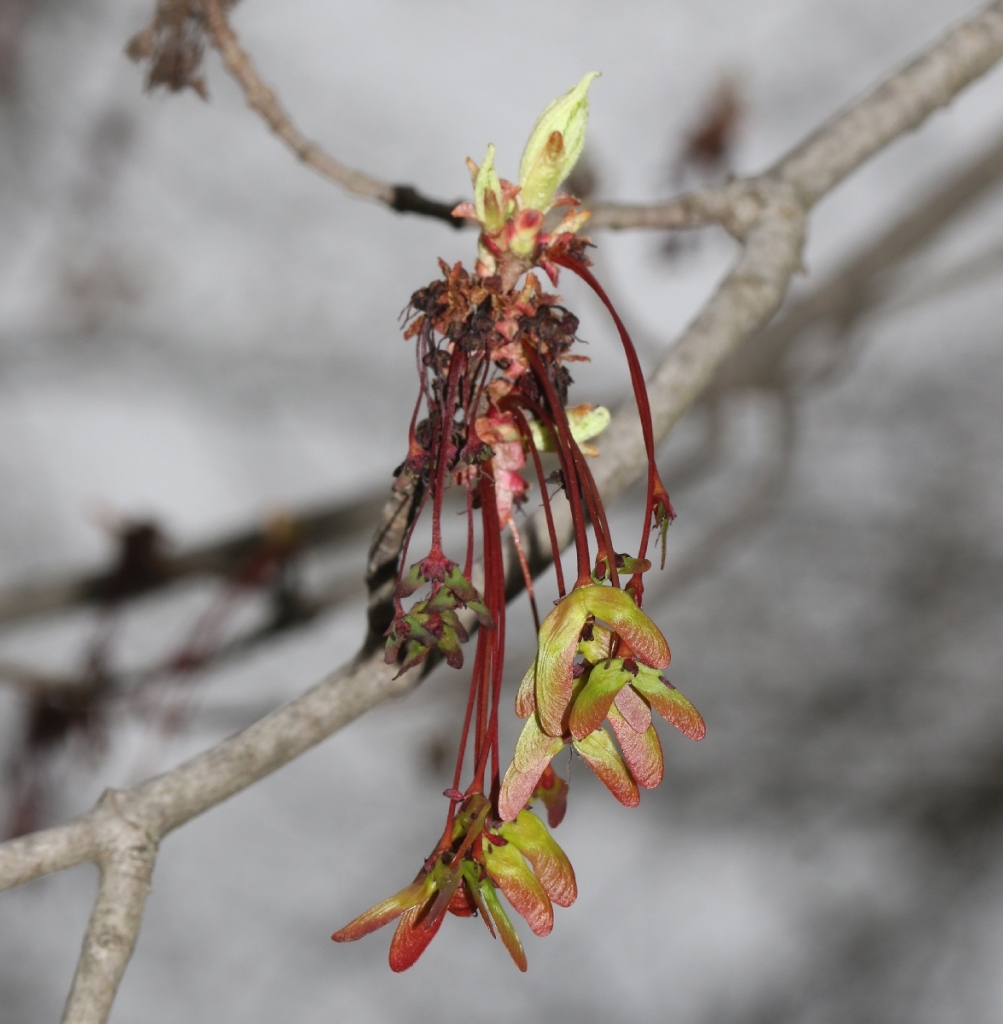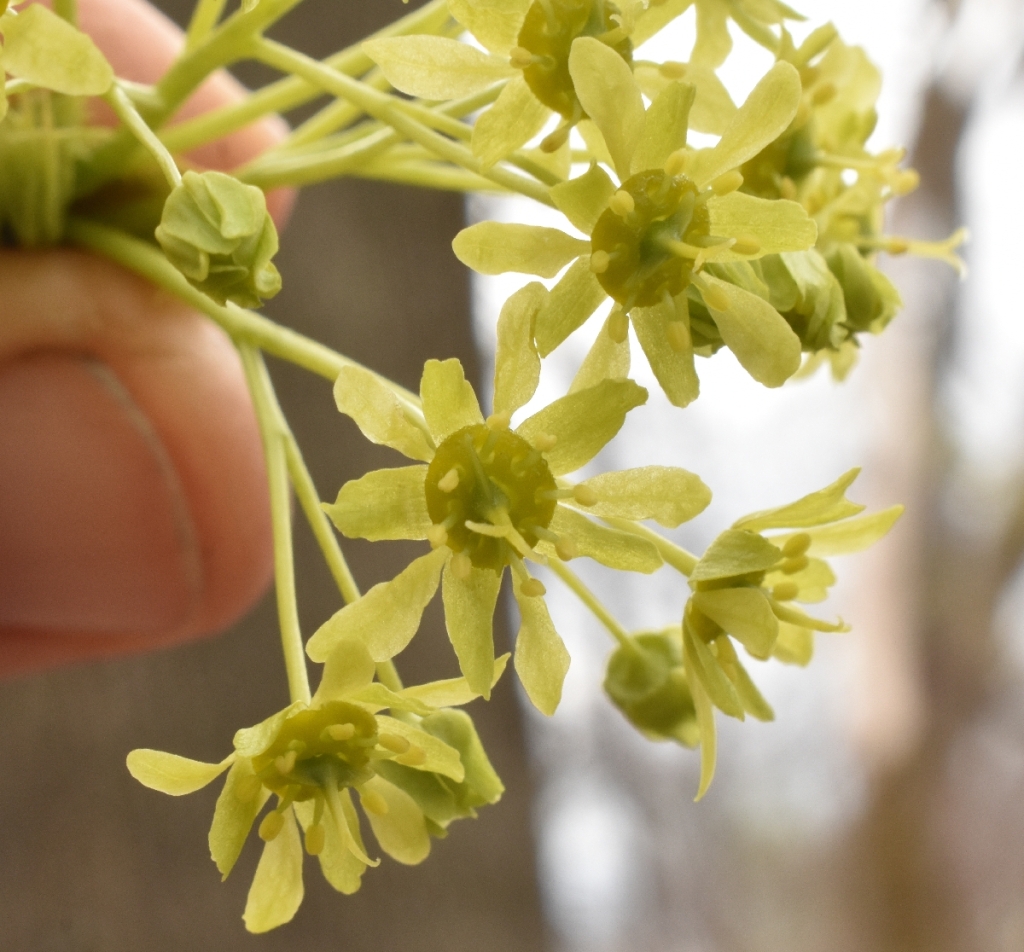By Claudia and Conrad
Over the last week, we have been keeping our eyes open and cameras ready to document some of the early tree flowers and fruits. We have become particularly fascinated by the different flowering/fruiting strategies of the maple species, who come into bloom each year in this order: Silver Maple, Red Maple, Box Elder, Norway Maple, Sugar Maple (which are all flowering right now or have already flowered), Striped Maple (which will soon flower), and Mountain Maple (which will flower in late May/June). Here is what the flowers/fruits of early maples (and some other trees) currently look like.
Silver Maple has separate male (pollen) and female (seed) flowers on the same tree. As you can see, it does not bother producing big showy petals. However, in spite of the minimalistic flower design, Honeybees regularly visit Silver Maple flowers to collect pollen. This image shows male flowers (note the pale orange pollen sacks) on top and female flowers (note the typical helicopter winged fruits in the making) at the bottom. The female flowers have a ring of stalkless staminoids (sterile pollen sacks):

The empty pollen sacks in male Silver Maple flowers. Silver Maple is in full bloom before the leaves come out. Now, that the flowers are spent, the leaves are emerging:

Another Silver Maple tree already has quite advanced fruits. They take but a few weeks to mature, fall off the tree, and germinate the same season:

Similar to Silver Maple, Red Maple also has separate male (pollen) and female (seed) flowers. Sometimes they are found on the same tree, but we also know some trees that consistently have only male flowers (pictured below):

Red Maple fruits developing in a cluster of female flowers. Red Maple also flowers before the leaves come out and the leaves start to emerge as the fruits are ripening:

Boxelder, in spite of its trifoliate or even pinnate leaves, which are a little bit reminiscent of those of Poison Ivy, is a true maple! Its male and female flowers are strictly on different trees. This is an image of the male (pollen) flowers, which are basically pollen sacks hanging on long stalks:

The female (seed) flowers of Boxelder have a two-parted stigma (pollen catching flower part), flanked by the fledgling wings of the typical maple helicopter fruits. Obviously, Boxelder times flowers at the same time as the leaves emerge:

The introduced Norway Maple is often planted as a shade tree in yards and along roadsides, but has a tendency to disperse into natural areas and is therefore considered invasive in our region. It has male (pollen) and female (seed) flowers on the same tree. Its flowers are more showy than those of the early-blooming native maples, complete with yellow green petals and sepals. Note how these male flowers have a ring of 10 stamens (pollen sacks at the end of long stalks), but no stigma (pollen catching flower part) in the center of the flowers:

In contrast, the female flowers of Norway Maple, which look superficially very similar to the male flowers, have shorter-stalked (and supposedly sterile) pollen sacks (called staminoids) surrounding the two-parted stigma at the center of the flower. If you look closely, you can discern that, like in other female maple flowers, the stigma is already flanked by the fledgling wings of the future helicopter fruits:

The last of our early-blooming maples to open its flowers is Sugar Maple. It, too, has male and female flowers on the same tree and this year we have not yet been able to see any female flowers up front. This image shows newly emerging male (pollen) flowers. Note how, like in all other maples, a whole bunch of flowers emerges from a single bud:

These are male (pollen) flowers of Sugar Maple are fully emerged and are spreading their pollen:

Looking ahead (with the image below taken in late May of another year), keep your eyes open for the pseudohermaphroditic (seemingly containing pollen- and seed-bearing flower parts, but usually only functioning as either pollen-producing or seed-producing) flowers dangling underneath the fully expanded leaves of Striped Maple. This native maple is a common understory tree in many of our forests:

And looking even further ahead (with the image below taken in mid June of another year), look for the male and female flowers displayed together in upright racemes above the fully expanded leaves of Mountain Maple. We know this, our rarest maple species, only from the eastern part of the County, where it grows as a shrub in cool ravines:

Coming back to late April, American Elm, which started blooming in late March, is now developing its small, papery, one-seeded fruits, which will soon disperse. Currently, all the green you can see on elm trees are these young fruits. The leaves have not begun to emerge, yet:

A fun tree to look at closely right now is Musclewood (Carpinus caroliniana). Like its relatives, the birches, hazelnuts, and Hop-hornbeam, it has separate male and female flowers on the same tree. A week ago, we took this image of the just expanding male catkins (slim, cylindrical flower clusters which contain many tiny flowers):

A few days later, we could see not only the fully expanded male catkins of Musclewood, but also the tiny clusters of female flowers (recognizable by their bright red stigmas, visible on the left side of the branch in the image below):

